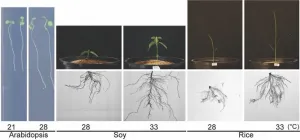(Press-News.org) LA JOLLA (June 4, 2024)—Global temperatures are on the rise, with experts projecting an increase of 2.7°F by 2050. Because plants cannot regulate their own temperatures, they are especially sensitive to these temperature changes. In higher temperatures, plants instruct their root systems to grow faster, creating long roots that stretch through the soil to absorb more water and nutrients. While this response may help the plants in the short term, new research suggests it’s both unsustainable for the plants and potentially harmful for humans in the long term.
Researchers at the Salk Institute have discovered that when certain plants respond to high temperatures with rapid root growth, they are reducing their levels of two important nutrients—nitrogen and phosphorus—which makes them less nutritious when consumed. At the same time, if the soil contains low amounts of these nutrients, plants return to slower root growth and don’t respond adequately to the higher temperatures.
The new molecular details of this interaction between root growth and nutrient availability in the face of high temperatures will inform the engineering of Salk Ideal Plants®—a collection of carbon-capturing, climate change-resilient wheat, rice, corn, and other crops created by Salk’s Harnessing Plants Initiative.
The findings were published in Nature Communications on June 1, 2024.
“Global warming will lead to significantly increased temperatures on Earth, and plants are inevitably going to respond,” says Salk Professor Wolfgang Busch, senior author of the study, executive director of the Harnessing Plants Initiative, and Hess Chair in Plant Science. “The fact that higher temperatures deplete these important nutrients in plants is a real concern for the future of human and animal diets, and certainly something we want to account for as we work to design more resilient crops.”
Plant growth and development change based on environmental temperatures in a process known as thermomorphogenesis. To gain a deeper understanding of this process, Salk researchers looked at Arabidopsis thaliana, a small flowering plant in the mustard family. In early experiments, they noticed the above-ground part of the plant, called the shoot, grew longer when exposed to high heat. This led the Salk team to wonder how these temperatures affected the plant’s roots, and whether crop plants, like rice or soybean, might respond similarly.
To answer these questions, the researchers turned up the heat and watched Arabidopsis, rice, and soybean plants’ roots grow. Just as Arabidopsis shoot growth accelerated under high temperatures, its roots, as well as the rice and soybean roots, accelerated their growth. But there was one caveat: the rapid growth relied on abundant access to nitrogen and phosphorus in the soil.
"Nitrogen and phosphorus are crucial for plant growth, development, and reproduction, so they are already in most fertilizers,” says Sanghwa Lee, first author of the study and a postdoctoral researcher in Busch’s lab. “Having connected the dots between these nutrients and thermomorphogenesis, we can now work to engineer plants and optimize fertilizers that ensure growth isn’t limited by lack of nitrogen and phosphorus in future higher temperatures.”
In Arabidopsis, the relationship between faster root growth and nitrogen and phosphorus levels hinged on two proteins: HY5 and NRT1.1. HY5 is a transcription factor, a type of protein that regulates when specific genes will be turned “on” or “off.” HY5 oversees the genetic instructions for NRT1.1, a protein that senses nitrogen and is involved in regulating phosphorus levels and the coordination of plant root growth.
In high temperatures, HY5 and NRT1.1 work together to conduct thermomorphogenesis. But as nitrogen and phosphorus levels fall, HY5 begins to suppress the expression of NRT1.1, and root growth slows down.
Both rice and soybean have similar proteins that share a common genetic ancestor with HY5 and NRT1.1. Busch says the rice and soybean versions of HY5 and NRT1.1 will require more investigation, but are likely to affect root growth and nutrient uptake similarly to Arabidopsis’ HY5 and NRT1.1.
“It is now clear that nitrogen and phosphorous are key in controlling root growth under the stress of higher temperatures,” says Busch. “This is going to be crucial to consider as we work to overcome the challenges that global warming poses on the large-scale production of nutritious food for a growing global population.”
In the future, the researchers will more deeply investigate rice, soybean, and other crops to determine if their HY5 and NRT1.1 protein lookalikes react similarly. They will also look at ways to target these proteins and develop crops that can continue growing their roots even when nitrogen and phosphorus are running low.
Other authors include Julia Showalter and Ling Zhang at Salk, as well as Gaëlle Cassin-Ross and Hatem Rouached at Michigan State University.
The work was supported by the Salk Harnessing Plants Initiative and Michigan State University.
About the Salk Institute for Biological Studies:
Unlocking the secrets of life itself is the driving force behind the Salk Institute. Our team of world-class, award-winning scientists pushes the boundaries of knowledge in areas such as neuroscience, cancer research, aging, immunobiology, plant biology, computational biology, and more. Founded by Jonas Salk, developer of the first safe and effective polio vaccine, the Institute is an independent, nonprofit research organization and architectural landmark: small by choice, intimate by nature, and fearless in the face of any challenge. Learn more at www.salk.edu.
END
Key nutrients help plants beat the heat
Salk scientists find higher temperatures drain plants of important dietary nutrients; findings will be used to engineer crops that are more resilient to climate change
2024-06-04
ELSE PRESS RELEASES FROM THIS DATE:
UTA scientists recognized nationally for inventions and innovation
2024-06-04
Researchers from The University of Texas at Arlington received 20 utility patents for their work in 2023, contributing to the University of Texas System’s overall ranking of No. 3 in the Top 100 U.S. Universities Granted U.S. Utility Patents in 2023 list.
Compiled by the National Academy of Inventors (NAI), the rankings are based on data obtained from the U.S. Patent and Trademark Office. The University of California system and Massachusetts Institute of Technology claimed the top ...
Inflight alcohol + cabin pressure may threaten sleeping passengers’ heart health
2024-06-04
The combination of alcohol plus cabin pressure at cruising altitude may threaten sleeping plane passengers’ heart health, particularly on long haul flights, suggests the first study of its kind, published online in the respiratory journal Thorax.
The duo lowers the amount of oxygen in the blood (SpO2) and raises the heart rate for a protracted period, even in the young and healthy, the findings indicate.
The higher the alcohol consumption, the greater these effects might be, particularly among older passengers and those with pre-existing medical conditions, say ...
High excess death rates in the West for 3 years running since start of pandemic
2024-06-04
Excess death rates have remained high in the West for three years running since the start of the COVID-19 pandemic, finds a data analysis of 47 countries published in the open access journal BMJ Public Health.
This is despite the implementation of various containment measures and the availability of COVID-19 vaccines, giving rise to “serious cause for concern,” say the researchers who call on governments and policymakers to thoroughly investigate the underlying causes.
The researchers wanted to gauge the effectiveness of the response to the health crisis ...
Facial thermal imaging + AI accurately predict presence of coronary artery disease
2024-06-04
A combination of facial thermal imaging and artificial intelligence (AI) can accurately predict the presence of coronary artery disease, finds research published in the open access journal BMJ Health & Care Informatics.
This non-invasive real-time approach is more effective than conventional methods and could be adopted for clinical practice to improve the accuracy of diagnosis and workflow, pending testing on larger and more ethnically diverse numbers of patients, suggest the researchers.
Current guidelines for the diagnosis of coronary heart disease rely on probability assessment of ...
New Durham University study shows selective breeding has constrained communication abilities in domestic dogs compared to wolves
2024-06-04
-With images and video-
A new study from researchers at Durham University has found that the process of domestication and selective breeding has limited the ability of domestic dogs to use facial expressions to convey affective states (emotions) as effectively as their wolf ancestors.
The research, published in Nature’s Scientific Reports, used an extended Dog Facial Action Coding System to analyse video recordings of captive wolves and domestic dogs during spontaneous social interactions and reactions to external stimuli.
The researchers identified nine distinct affective ...
Frequent mowing puts poisonous weed into survival mode
2024-06-04
By John Lovett
University of Arkansas System Division of Agriculture
Arkansas Agricultural Experiment Station
FAYETTEVILLE, Ark. — A study of the effects of mowing on a common weed has found that what doesn’t kill you can make you stronger.
A study published in Nature’s Scientific Reports has found that frequent mowing of Solanum elaeagnifolium may help create a “superweed.”
Solanum elaeagnifolium — also known as silverleaf nightshade — can be found from south Texas to South Africa and Greece, infesting fields and soaking up valuable nutrients intended for cash crops. The weed with purple flowers – sometimes white and light ...
University of Nevada, Reno team develops new vegetation mapping tools
2024-06-04
RENO, Nev. – Powerful new digital mapping tools developed by University of Nevada, Reno researchers hold promise to improve management of rangeland, particularly public lands in the far-flung Western United States.
The significant improvements in mapping of vegetation enabled by the University’s research provide managers of rangeland, ranchers as well as federal managers of public lands, with better information to make large-scale decisions to mitigate effects of grazing, wildfire and other potential disruptions.
The research ...
Unveiling how German cockroaches came to live with humans
2024-06-04
by Brooke McDonald
It turns out a common cockroach found across the globe is a pest of our own making.
In a study recently published in Proceedings of the National Academy of Sciences, Texas A&M AgriLife researchers unveiled insights into the origins of the common German cockroach, Blattella germanica.
The study, “Solving the 250-year-old ...
Sarcoma clinical trial funded by stand up to cancer reduces risk of relapse by 43%
2024-06-04
LOS ANGELES – June 3, 2024 – For the last three decades, breakthroughs have been sparse for soft tissue sarcomas, which are rare cancers that affect muscles, fat and other connective tissues. Today, a global team of researchers funded by a Stand Up To Cancer® (SU2C) grant announced clinical trial results that point to a new immunotherapy treatment option for two of the most common types of soft tissue sarcoma in adults, a breakthrough that reduces the risk of relapse by 43% at two years and will ...
Discovery of shared genetic links between sleep, neurodevelopmental, and neuropsychiatric conditions may lead to the development of new treatments
2024-06-04
Berlin, Germany: Disturbed sleep is very common in almost all neuropsychiatric and neurodevelopmental conditions (NDPCs), such as autism, attention deficit and hyperactivity disorder, schizophrenia, and bipolar disorder. While it is understandable that the symptoms of such conditions would lead to sleep disruption and also that sleep disruption would worsen symptoms in these conditions, Irish researchers have now found new genetic associations between some of these conditions and chronotype, the behavioural manifestations of an individual’s ...
LAST 30 PRESS RELEASES:
Numbers in our sights affect how we perceive space
SIMJ announces global collaborative book project in commemoration of its 75th anniversary
Air pollution exposure and birth weight
Obstructive sleep apnea risk and mental health conditions among older adults
How talking slows eye movements behind the wheel
The Ceramic Society of Japan’s Oxoate Ceramics Research Association launches new international book project
Heart-brain connection: international study reveals the role of the vagus nerve in keeping the heart young
Researchers identify Rb1 as a predictive biomarker for a new therapeutic strategy in some breast cancers
Survey reveals ethical gaps slowing AI adoption in pediatric surgery
Stimulant ADHD medications work differently than thought
AI overestimates how smart people are, according to HSE economists
HSE researchers create genome-wide map of quadruplexes
Scientists boost cell "powerhouses" to burn more calories
Automatic label checking: The missing step in making reliable medical AI
Low daily alcohol intake linked to 50% heightened mouth cancer risk in India
American Meteorological Society announces Rick Spinrad as 2026 President-Elect
Biomass-based carbon capture spotlighted in newly released global climate webinar recording
Illuminating invisible nano pollutants: advanced bioimaging tracks the full journey of emerging nanoscale contaminants in living systems
How does age affect recovery from spinal cord injury?
Novel AI tool offers prognosis for patients with head and neck cancer
Fathers’ microplastic exposure tied to their children’s metabolic problems
Research validates laboratory model for studying high-grade serous ovarian cancer
SIR 2026 delivers transformative breakthroughs in minimally invasive medicine to improve patient care
Stem Cell Reports most downloaded papers of 2025 highlight the breadth and impact of stem cell research
Oxford-led study estimates NHS spends around 3% of its primary and secondary care budget on the health impacts of heat and cold in England
A researcher’s long quest leads to a smart composite breakthrough
Urban wild bees act as “microbial sensors” of city health.
New study finds where you live affects recovery after a hip fracture
Forecasting the impact of fully automated vehicle adoption on US road traffic injuries
Alcohol-related hospitalizations from 2016 to 2022
[Press-News.org] Key nutrients help plants beat the heatSalk scientists find higher temperatures drain plants of important dietary nutrients; findings will be used to engineer crops that are more resilient to climate change





